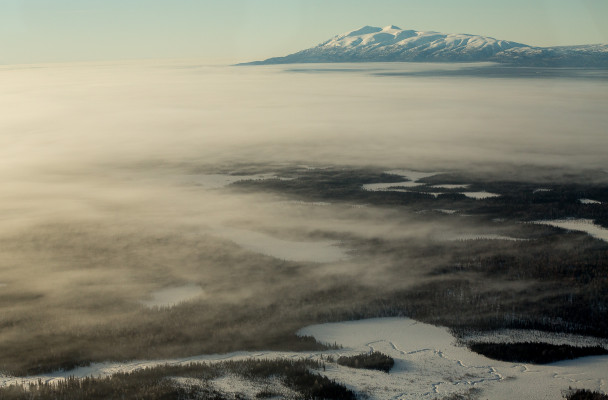
While mushers along the Iditarod are enjoying good trail conditions, the same isn’t true for the Iditasport. The event bills itself as a “human powered ultramarathon,” where participants bicycle and walk the traditional Iditarod route. It ended prematurely when all the competitors scratched.
The first Iditasport was in 1997, but it went defunct in the 2000s. This year, to commemorate the 20th anniversary, it was relaunched. Though poor snow conditions along one section of the trail re-routed the Iditarod sled-dog race, the three Iditasport participants set out from Big Lake and toward the Alaska Range on the heels of the Iron Dog in mid-February. But getting just halfway to Nome was nearly impossible.
Jan Kriska looks severely beaten up.
“I’ve been frostbitten now, 4-5 days ago, they were my fingers. They were a minor frostbite, but they became a major frostbite.
Kriska is a doctor, originally from Slovakia, but now living on a farm in North Carolina. His nose is discolored, fat bandages swaddle fingers that look a disturbing shade of purple, and he can barely walk.
“Friction and the pressure and no circulation plus cold caused big chunks of foot ya know, side of the foot to be missing.”
We’re talking in Ruby, which Kriska was only just barely able to reach as he ran, walked, and post-holed through hundreds of miles of remote country. He’s one of three people who entered the Iditasport hoping to reach Nome following the traditional Iditarod route. But this year, because the sled-dog race was re-routed to Fairbanks, there was less traffic along the trail heading up and over the Alaska Range toward the Yukon. And recent snows, along with deep cold, make things even more challenging.
“The accumulation of the snow later on, the section between McGrath and Ruby was essentially, there was no trail because Iron Dog had gone through a long time ago, then, accumulation of the new snow abolished the existing trail.”
Though the Iditasport requires entrants to have completed an “Alaskan winter event,” it only has to total 370 miles. Survival training is mandatory, but the program is just eight hours long. Kriska has done other cold weather races, but he wasn’t prepared when things started going wrong.
“It was… I thought I wasn’t gonna make it. I lost my snowshoes. Then, I didn’t have matches, so I couldn’t make water. It was (negative) 40°. Then, the stove stopped working. So I decided I’m not gonna bivy out anymore, so I pushed the last 30 miles through the night and came here (at) 3 o’clock in the morning.”
He was in touch with race organizers through a two-way communicator, so they had an idea of where he was and what was going on. But even Kriska says he didn’t know how bad things were until he visited the clinic in Ruby and saw the extent of the damage to his feet. Iditasport doesn’t have staff beyond McGrath, where a number of participants ended a similar, shorter outdoor race. Now, Kriska is preparing to catch a plane back to Anchorage.
He isn’t alone. Another runner trying to reach Nome is Jorge Latre who reached Ruby a few hours after Kriska flew out.
“You’re going at less than a mile an hour, and you’re in a thousand-mile race, so you think you’re gonna spend the rest of your life doing that. The last three nights were very cold, all below negative 30°, so it took a lot of skill not to lose your fingers or toes or nose. As you had to go about your normal routine, like, just putting on and off your gators, that time is enough to freeze your fingers off. So, every single activity becomes harrowing and difficult.”
Latre is in much better shape than his trail mate. Though he’s got a bandage over his nose, he looks otherwise unscathed as he shovels down a plate of fresh fruit, pancakes, and breakfast meats. But he’s not going any further. He thinks it was just a rough year in terms of conditions and doesn’t see the need to push his luck. Latre believes the safety precautions for the race are adequate, so long as you know how to identify trouble.
“People know where you are, and you send for an SOS, you can call for help, you can call with questions, so you have a line and people know where you are. If things get totally out of hand, you can get rescued or pull through self-rescue. But absent that: you’re on your own.”
Neither Latre or Kriska knew if they’d try the race again.
